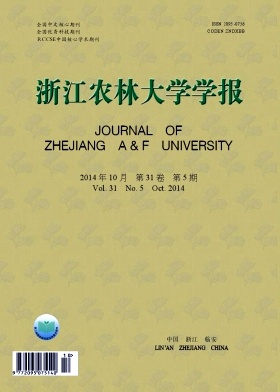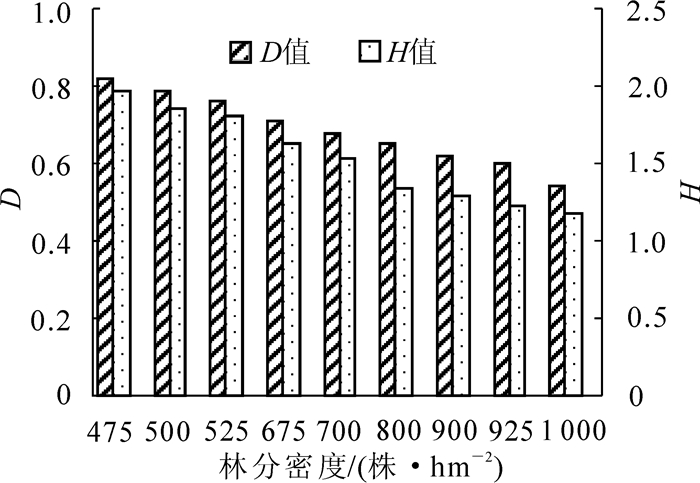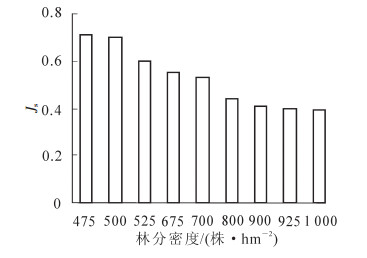-
生物多样性及保护的研究是倍受关注的生态学问题[1]。森林作为陆地最重要的生态系统类型,其生物多样性一直是生态学研究的热点[2]。林下草本植物作为森林的重要组成部分,在维持森林生态系统功能方面起着重要的作用[3-4]。不同类型的森林群落具有不同的物种多样性,如阔叶林、泰加林、热带雨林及季节性干旱森林等均表现了物种多样性的差异[5-8]。林分密度对林下草本植物多样性有明显影响[9];也有研究表明,林分密度对草本植物多样性影响不明显[10]。林分密度对林下草本植物多样性的影响还需进一步研究。山西省关帝山庞泉沟自然保护区是华北地区天然次生林重要的分布区,其中云杉Picea是该地区主要树种,以云杉为主的森林群落对该地区生态系统的维持起着重要的作用。曾有文献采用方差均值比,Morisita指数Iq,负二项参数K等测定了寒温性针叶林物种的分布格局[11];采用数量分析的方法研究了关帝山庞泉沟主要森林群落华北落叶松林和云杉林及其交错区的植物多样性[12];采用Rao指数和群落加权平均数(CWM)指数计算群落的功能多样性指数[13]。本研究以华北山区典型的云杉林为研究对象,选择不同密度的云杉林分,调查林下草本植物物种组成,分析林下草本植物多样性,旨在了解在以云杉为代表的寒温性针叶林中,林分密度对林下草本植物多样性是否有明显的影响,为深入了解云杉林森林生态系统生物多样性提供基础,同时为云杉林可持续经营管理提供参考。
HTML
-
研究地在山西省庞泉沟国家级自然保护区,地处吕梁山脉中段,位于山西省交城县西北部和方山县东北部,37°45′~37°55′N,111°22′~111°33′E,海拔为1 600~2 831 m。该区南北长15.0 km,东西长14.5 km,总面积为10 443.5 hm2。研究地气候属于暖温带大陆性季风气候,1月平均气温为-10.2 ℃,7月平均气温为17.5 ℃,年平均气温为4.2 ℃;年平均降水量822.6 mm,全年降水量极不均匀,多集中于7-8月,占全年降水量的75%以上;年平均蒸发量1 268.0 mm,相对湿度71%。土壤为山地棕壤,平均土层厚度70 cm,腐殖质层厚8 cm[12]。
庞泉沟自然保护区植被茂盛,植被覆盖率高达95%。云杉(包括青扦Picea wisonii和白扦Picea meyeri)和华北落叶松Larix principis-rupprechtii为主要的建群种。此外还有油松Pinus tabuliformis,山杨Populus davidiana,白桦Betula platyphylla,红桦Betula albo-sinensis,辽东栎Quercus wutaishannica等。灌木主要有沙棘Hippophae rhamnoides,土庄绣线菊Spiraea pubescens,忍冬Lonicera japonica,灰栒子Cotoneaster acutifolius等。草本植物有舞鹤草Maianthemum bifolium,小红菊Dendranthem achaneti,唐松草Thalictrum aquilegifolium,细叶薹草Carex stenophylla和茜草Rubia cordifolia等。
-
在研究区选择不同密度的云杉林,各密度的云杉林设3个样地,样地的面积为20 m×20 m,设置1 m×1 m的草本植物调查样方9个·样地-1,共设81个草本植物的调查样方。样地林分基本特征见表 1。
-
在2013年6月对每个样地进行调查。对样地内乔木进行每木检尺,测定其胸径、树高、枝下高、郁闭度(表 1);对样地内的草本样方进行调查,记录草本样方内出现的所有草的种类、株数(丛数)、盖度、高度等。
样地 密度/(株·hm-2) 海拔/m 坡向(°) 树高/m 胸径/cm 枝下高/m 郁闭度 1 475 1 900~1 950 NE 23.8 36.2 4.8 0.65 2 500 1 900~1 950 NE 25.8 36.8 6.7 0.70 3 525 1 900~1 950 NE 23.9 29 4.9 0.70 4 675 1 800~1 850 NW 21.1 24.4 7.1 0.85 5 700 1 800~1 850 NW 20.4 24.4 5.7 0.83 6 800 1 800~1 850 NW 21.3 23.8 6 0.87 7 900 1 800~1 850 NW 20.4 23 7.6 0.90 8 925 1 800~1 850 NW 21.8 26.3 7.8 0.89 9 1 000 1 800~1 850 NW 23.2 23.6 9.7 0.91 Table 1. Basic characteristics of stands in different densities
-
本研究的物种多样性采用多样性指数、物种丰富度、均匀度指数等来表征。Simpson多样性指数(D):$D=1 - \sum\limits_{i=1}^s {P_i^2} $。Shannon-Wiener多样性指数(H):$H=- \sum\limits_{i=1}^s {{P_i}} \ln {p_i}$。Patrick丰富度(R):R=S。Pielou均匀度指数(Js):${J_{\rm{s}}}=\frac{H}{{\ln S}}$。其中:Pi=ni/N, ni为样方内某物种的个体数,N为样方内所有物种的个体数;S为样地内物种数。
2.1. 样地设置
2.2. 植被调查
2.3. 物种多样性分析[14-15]
-
在研究区的云杉林中共调查到37种草本植物,隶属于18个科35个属。既有一些百合科Liliaceae,菊科Compositae和毛茛科Ranunculaceae等世界性大科,又有一些少种科。其中百合科和菊科的物种数最多,都为6种,占草本植物种的16.2%,有10个属只有1个物种,其属、种分别占样地的28.6%和27.0%。其详细信息见表 2。

Table 2. Composition of herbs in spruce forest
-
物种多样性是群落结构的重要指标,通过多样性指数可以间接反映出群落功能的特征。本研究选用Simpson指数(D)和Shannon-Wiener指数(H)进行物种多样性测度。由图 1可知:草本植物的Simpson指数和Shannon-Wiener指数随着林分密度的增加而减小。当林分密度为475株·hm-2时,多样性指数(D和H)分别为0.82和1.97;当林分密度为1 000株·hm-2时,多样性指数(D和H)分别为0.54和1.18。
-
Pielou均匀度指数(Js)表示群落均匀度的指标,它可以反映群落中个体数量分布的均匀程度。由图 2可知,随着林分密度的增加,云杉林下草本植物的均匀度指数逐渐减小。当林分密度为475株·hm-2时,均匀度指数为0.71;当林分密度为1 000株·hm-2时,均匀度指数为0.39。
-
丰富度是指群落中物种数目的多少。一般情况,当物种数目越多,丰富度就越大;相反,物种数目越少,丰富度越小。本研究中物种的丰富度与林分密度之间没有一定的变化规律(图 3)。
-
林分密度与草本植物多样性指数的相关性分析表明(表 3):林分密度与Shannon-Wiener多样性指数(H),Pielou均匀度指数(Js)和Simpson多样性指数(D)呈极显著的负相关,其中Simpson多样性指数(D)受林分密度的影响最大;Shannon-Wiener多样性指数(H)与Pielou均匀度指数(Js)和Simpson多样性指数(D)呈极显著的正相关;Pielou均匀度指数(Js)和Simpson多样性指数(D)呈极显著正相关;物种丰富度(S)与Shannon-Wiener多样性指数(H),Pielou均匀度指数(Js)和Simpson多样性指数(D)都呈负相关,而与林分密度呈显著正相关。
林分密度 H Js D S 林分密度 1 -0.9875** -0.9697** -0.9886** -0.7503* H 1 0.9835** 0.9835** -0.7630* Js 1 0.9683** -0.8608** D 1 -0.7283* S 1 *表示在0.05水平下显著,**表示在0.01水平下极显著。 Table 3. Correlation coefficients between stand density and diversity index of herbaceous plants
3.1. 云杉林下草本植物物种组成
3.2. 不同密度的林分中草本植物多样性指数的变化
3.3. 不同密度林分中草本植物均匀度指数的变化
3.4. 不同密度林分中草本植物丰富度的变化
3.5. 林分密度与草本植物多样性指数的相关性分析
-
在本研究区,不同密度云杉林下草本植物的多样性存在明显差异。随着林分密度的增加,草本植物的Simpson多样性指数(D值)、Shannon-wiener多样性指数(H值)和均匀度指数(Js)都逐渐减小。此外,林分密度与草本植物多样性指数都具有一定的相关性。
已有研究表明[16-17],随着林分密度的增加,不同密度林下草本植物的多样性指数(Simpson多样性指数和Shannon-Wiener指数)逐渐减小,这与本研究结果一致。但是,李民义等[9]和吕婧娴等[10]对不同密度林下草本植物多样性的研究表明:随着林分密度的增加,草本植物多样性指数表现为先增大后减小的趋势。出现上述不同结果的原因可能是随着林分密度的增加,林下微环境(如光照、温度、水分等)受到较复杂的影响,从而引起草本植物多样性指数出现上述复杂的变化。一些学者研究表明:随着林分密度的增加,不同密度林下草本植物的均匀度指数逐渐减小[15-17],这与本研究结果一致。可能随着林分密度的增加,林隙减少,从而导致均匀度指数减小。吕婧娴等[10]对不同密度林下草本植物多样性的研究表明:随着林分密度的增加,物种丰富度没有一定的变化规律,这与本研究结果一致。其可能原因是物种丰富度指数受多种因素(如海拔、坡向、土壤条件等)的共同作用。Risser等[18]认为只有Shannon-Wiener指数与林分密度呈负相关,其他物种多样指数的变化并无一定的规律。本研究的云杉林为寒温性常绿针叶林,为亚高山暗针叶林的一个组成部分,枝冠稠密常绿,林木自然整枝不良,林下潮湿阴暗,灌木稀少,盖度小于20%。尤其在密度大的林分中,林下光照不足,草本植物种类和数量较少,草本植物多样性指数较小,均匀度指数也相对小。在密度相对小的林分,光照条件相对好,草本植物多样性指数和均匀度指数相对高。本研究中不同密度的林分,丰富度没有规律性变化,这表明林下草本植物个体数量和物种数不仅受光照的影响,而是多种因素综合作用的结果。此外,林木密度对林下草本植物个体数量和物种数的影响作用不能明显地表现出来。
草本植物多样性受多种因素的影响,例如地形、光照、林冠层的分布、土壤肥力等。曹云生等[21]对不同的森林群落的地形因子进行典范对应分析(CCA)排序,认为坡向是影响草本植物多样性差异的最主要地形制约因子,海拔与草本植物多样性指数、均匀度指数和丰富度指数呈现正相关。有研究指出,林下总光照和林冠开阔度对草本植物的影响最大,并且林隙光照对林下植物的分布有明显的指示作用,大林隙内草本植物的丰富度明显高于小林隙的[20]。林冠层的分布又影响光照环境和净降水量的分布,从而影响草本植物的多样性[21]。白永飞等[22]对锡林河流域和沙坡头人工植被植物群落的研究表明:物种丰富度和多样性指数与土壤有机碳及全氮含量呈正相关。文海燕等[23]对草本植物的多样性研究表明:草本植物物种多样性与土壤有机碳、全氮、全磷和有效氮呈正相关。草本植物多样性受多种环境因子的制约,各种环境因子又相互作用共同影响植物多样性。要全面了解不同密度云杉林下草本植物的多样性。需将草本植物的生理生态学特征与林分微环境利用状况以及群落的种间关系结合起来做进一步研究。
草本植物是森林生态系统生物多样性的重要组成成分。促进林下草本植物的良好发育,必然大大提高森林生态系统的物种多样性。在森林抚育管理中,不仅要考虑乔木的保留密度,同时要兼顾林下植物的多样性,通过合理调控林分密度,适当提高林下草本植物多样性,可增加林分的稳定性。






 本站查看
本站查看




 DownLoad:
DownLoad: